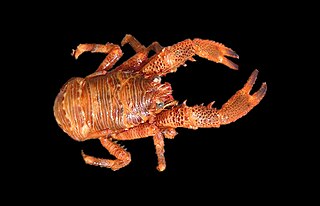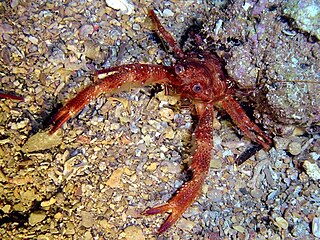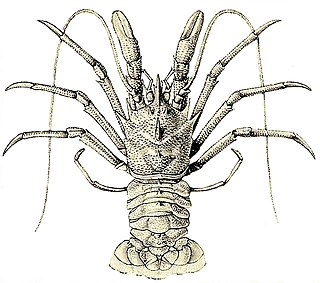
Galathea is a genus of squat lobsters in the family Galatheidae. It is one of the largest genera of squat lobsters that in 2008 contained 70 species. Most species of Galathea live in shallow waters.
Munidopsis andamanica is a species of squat lobster that lives in the deep sea and eats dead wood. It has long chelipeds, which are twice as long as the carapace.

Galathea intermedia is a species of squat lobster in the family Galatheidae. It is found in the north-eastern Atlantic Ocean, as far north as Troms, Norway, south to Dakar and the Mediterranean Sea.

Galathea strigosa is a species of squat lobster in the family Galatheidae. It is found in the northeast Atlantic Ocean, from the Nordkapp to the Canary Islands, and in the Mediterranean Sea and Red Sea. It is edible, but not fished commercially. It is the largest squat lobster in the northeast Atlantic, reaching a length of 90 millimetres (3.5 in), or a carapace length of 53 mm (2.1 in), and is easily identified by the transverse blue stripes across the body.

Munidopsis is a genus of squat lobster. It is the second largest of all the genera of squat lobsters, after Munida, with over 200 species. Its members are mainly found on continental slopes and on abyssal plains. A few fossil species are also known, including specimens from the Campanian (Cretaceous).

Eumunida picta is a species of squat lobster found in the deep sea. The species is strongly associated with reefs of Lophelia pertusa, a deep-water coral, and with methane seeps. It is abundant in the western Atlantic Ocean, where it is found from Massachusetts to Colombia.
Anomoeomunida is a monotypic squat lobster genus in the family Munididae. The sole a species of is Anomoeomunida caribensis. It occurs in the western Atlantic.

Coralliogalathea is a genus of squat lobsters in the family Galatheidae. Initially thought to be monotypic, solely represented by Coralliogalathea humilis, recent analysis has split the genus into six, morphologically similar but genetically different species.

Crosnierita is a genus of squat lobsters in the family Munididae, containing the following species:
Enriquea leviantennata is a species of squat lobster in a monotypic genus in the family Munididae.

Galacantha is a genus of squat lobsters in the family Munidopsidae, containing the following species:

Heteronida is a genus of squat lobsters in the family Munididae. They occur in the western Pacific Ocean.

Lauriea is a genus of squat lobsters in the family Galatheidae, containing the following species:

Neonida grandis is a species of squat lobster in a monotypic genus in the family Munididae.
Phylladiorhynchus is a genus of squat lobsters in the family Galatheidae, containing the following species:
Setanida cristata is a species of squat lobster in a monotypic genus in the family Munididae.
Tasmanida norfolkae is a species of squat lobster in a monotypic genus in the family Munididae.
Munidopsis tuberosa is a species of squat lobster, first isolated from deep waters off Taiwan. M. tuberosa is similar to M. granosicorium, but it differs by the configuration of its carapace and rostrum.
Munidopsis echinata is a species of squat lobster, first found in deep waters off Taiwan. M. echinata is similar to M. colombiana, but differs by lacking an antennal spine on its carapace and having a rather longer antennal peduncle.
Munidopsis tafrii is a species of squat lobster first found in Taiwanese waters at depths greater than 3,000 metres (9,800 ft). It resembles M. ceratophthalma, however its carapace morphology distinguishes it from its cogenerate species.











